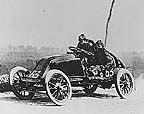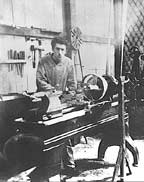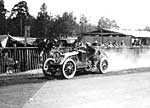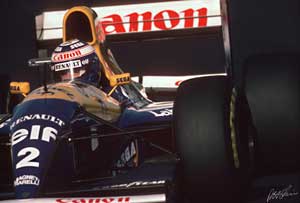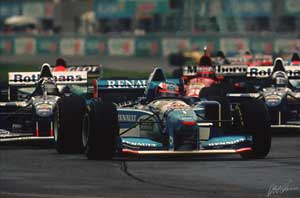Features - News Feature
FEBRUARY 22, 2002
Renault - 100 years of topline racing
BY JOE SAWARD

Renault comes back to Formula 1 this season with a full factory team - 100 years after the company's first major victory in automobile racing. And while victory this year may be difficult there is little doubt that the team will be more competitive than was the case in 2001.
Competition was an important element in Renault's philosophy when the company was established by Louis, Marcel and Fernand Renault, three sons of a Paris button-maker, in 1899. Louis was the engineer and at the age of 11 designed an electric lighting system for his bedroom. At 14 he began to tinker with a Panhard engine and when he finished his military service in 1898 he built his first car in a shed at the end of the garden of the Renault family house in the Paris suburb of Billancourt. This was powered by a De Dion Bouton engine but the chassis was designed by Louis and the major innovation was that it featured a driveshaft transmission rather than the normal chain-drive system.
In the summer of 1899 Societe Renault Freres entered cars in the Paris-Trouville race and Louis won the light car class. After that customers began to appear and in the six months that followed the brothers and their hastily assembled production team built 60 cars. The following year they built 179. Renault's early racing success was restricted to class wins in the city-to-city races but after a couple of years of success the company was strong enough to plan for its own engines and hired one of the De Dion Bouton engine designers and he produced the first Renault engine. This made it debut on the Paris-Vienna marathon at the end of June. The event was actually two events rolled into one with the Gordon Bennett Cup cars running only from Paris-Innsbruck and the rest of the entry going on to Vienna.
|
|||||||||||||
With Edge out of the way and the other main contenders having retired or been delayed Marcel Renault was the first man to make it to Vienna, 12 minutes ahead of Henri Farman's Panhard. It was a famous victory and the business boomed. Racing was catching on and the entry for the next big event, the 1903 Paris-Madrid, was an enormous 275 vehicles.
But there would be tragedy. On the first day of racing there were a series of accidents. The number of casualties has never been fully established but there were around a dozen accidents which led to fatalities. Marcel Renault was seriously injured when he went off the road not far from Poitiers. Louis Renault was second when the race reached Bordeaux and the decision was taken to cancel the rest of the event.
Two days later Marcel died. Louis gave up racing. In 1904 he sold a car to Gould Brokaw, an American millionaire, and this was raced without success in the US, and it was not until 1905 that Louis agreed to build another racing machine. This new device carved its place in history in 1906 when Louis's old co-driver Ferenc Szisz won the inaugural Grand Prix de l'ACF in 1906 - the event which is generally regarded as having been the first real "Grand Prix".
For the next two years Renault was a regular player in Grand Prix events but then the French manufacturers decided not to race and Renault disappeared from Grand Prix racing for nearly 70 years. Fernand Renault died in 1908 and so Louis was left to run the firm which he built up dramatically during the inter-war years. Forced to put his factories into production for German armaments after the invasion of France in 1940, Louis was arrested by the Free French after the liberation and died in prison before he could clear his name. As a result the Renault company became national property and with the 4CV and the Dauphine models became one of the strongest car companies in the world.
Renault avoided competition until one of its dealers Jean Redele established the Alpine tuning business and began preparing Renault products for rallying. This developed in the course of the 1950s and Alpine-tuned Dauphines later won the Tour de Corse and the Monte Carlo Rally.
It was not until the late 1960s that Renault began to look seriously at car racing and established the Renault 8 Gordini Cup, which stimulated the growth of French motorsport. This was followed by success in the European Rally Championship in 1970 with Jean-Claude Andruet in an Alpine Renault A110 and World Championship success in 1971 with Ove Andersson, Bernard Darniche, Jean-Luc Therier and Jean-Pierre Nicolas. There would be a second World Championship in 1973 and Alpine Renault rally cars continued to do well until 1976.
Renault's track racing was also developed with the introduction of Formula Renault in 1971 and the 2-liter sportscar program which resulted in European Championship success in 1974.
In 1975 Renault took over Gordini and the Renault-Gordini operations were consolidated at Viry-Chatillon as Renault Sport. In 1976 Jean-Pierre Jabouille gave Renault victory in the European Formula 2 Championship and in 1978 Renault won the Le Mans 24 Hours with the Alpine Renault of Didier Pironi and Jean-Pierre Jaussaud. In January 1977 the new company admitted that it had a Formula 1 project with a turbocharged engine. The car first appeared at the British GP in July 1977 with Jabouille driving. At the time the idea of turbocharging F1 cars seemed ludicrous and "The Yellow Teapot" was the butt of F1 jokes but by 1979 Jabouille and his new team mate Rene Arnoux were increasingly competitive and at the French GP a tearful Jabouille gave the company its first victory in the F1 World Championship.
Jabouille seriously injured his legs in a crash at the end of 1980 and his place in the team was taken in 1981 by Alain Prost who won three victories and twice finished second to end the year fifth in the World Championship with Renault third in the Constructors' title. In 1982 the team scored four wins and Renault was again third in the Constructors' title. Arnoux departed and Renault signed up Eddie Cheever to partner Prost. The 1983 season was to prove a big disappointment despite the fact that Prost won four Grands Prix. Brabham-BMW won the title and at the end of the year the old team broke up. Renault hired Patrick Tambay and Derek Warwick but neither they nor Renault's customer teams won any races and there was further restructuring for 1985. That year the Renault chassis was not very competitive but Renault collected wins thanks to customer team Lotus with Ayrton Senna winning in Portugal and Belgium and Elio de Angelis in Imola.
|
|||||||||
Renault returned to F1 in 1988 deciding to be simply an engine supplier. The relationship with Williams proved to be enormously successful with Thierry Boutsen winning the team's first victory in the sixth race of the new partnership. The Belgian added a second victory at the end of the year although the more consistent Riccardo Patrese finished third in the World Championship despite not winning a race. Williams-Renault finished runner-up in the Constructors' title. The 1990 season was disappointing with Patrese and Boutsen winning only one race each but in 1991 the team hired Nigel Mansell to partner Patrese and by mid-season the pair were winning races. There were seven wins (Mansell taking five and Patrese two) but Mansell was beaten to the title by Ayrton Senna's McLaren-Honda. In 1992, however, there was no doubt that Renault was finally dominant. Mansell won nine victories (Patrese scored one) and the two-men finished 1-2 in the World Championship and Williams-Renault won the Constructors' title.
After that success followed success: Alain Prost won the title in 1993 and after the death of Senna in 1994 Damon Hill challenged for the title. For 1995 Renault decided to supply Williams and Benetton and Michael Schumacher steered his Benetton-Renault to the World Championship.
After Schumacher left Benetton to join Ferrari, Williams overshadowed Benetton with Damon Hill winning the title in 1996 and Jacques Villeneuve following suit in 1997.
Renault then withdrew again although the old engines continued to be raced under the Mecachrome, Supertec and Playlife badges.
At the start of 2000 Renault announced that it had bought the Benetton team and would be returning to F1 with a Renault team in 2002 to open a new chapter in Renault's racing history. On paper the team looks to be good with the Englishmen Mike Gascoyne and Steve Nielsen looking after the technical and organizational side of the team. The wide-angled Renault V10 engines, which are built by Jean-Jacques His's team in Paris, seem to be a little more powerful than last year's version. And with Jarno Trulli and Jenson Button for drivers the team is not lacking in natural speed.
If victory this seems a little far-fetched one should remember back 100 years when no-one would have put much money on Marcel Renault winning the Paris-Vienna...
